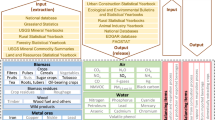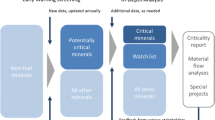Abstract
Most of the international mineral statistics are limited to production, import and export figures only. However, such statistics are not sufficient to identify possible market trends or supply risks. The political restructuring in Europe and China’s rapidly increasing demand for mineral raw materials since the turn of the millennium has led to imbalances in the demand and supply of raw materials in many countries. In the present work, the importance of a more in-depth exploratory data analysis is explained. The paper also deals with the need to record raw material exploration projects. While most statistics are limited to the production figures and thus only allow a retrospect into the past only, information about the resources verified in exploration projects would also allow a glimpse into the future. Despite this need, many institutions that have compiled such statistics in the past have discontinued them meanwhile. Reduced budget and staff shortages are some of the reasons for this. For this reason, close cooperation between the few remaining organizations is urgently required.


source: WORLD MINING DATA 2021)

(source: WORLD MINING DATA 2021)

(source: WORLD MINING DATA 2021). Abbreviations: CAS, Central Asia; CPA, China, Centrally Planned Asia; EEU, Eastern Europe; FSU, Former Soviet Union; LAM, Latin America; MEA, Middle East; NAF, North Africa; NAM, North America; PAO, Pacific OECD; PAS, Pacific Asia; SAS, South Asia; SSA, Sub-Saharan Africa; WEU, Western Europe

(source: WORLD MINING DATA 2021)




(source WORLD MINING DATA 2021). Conversion factor for natural gas (approximate method): 1 m3 = 0.8 kg = 0.0008 metr. t

(source WORLD MINING DATA 2021)







Similar content being viewed by others
References
Canadian Securities Administrators (CSA) (ed): Canadian Securities Regulatory Standards for Mineral Projects.- NI 43-101: https://mrmr.cim.org/en/standards/canadiansecurities-regulatory-standards-for-mineral-projects/
Elsner, H. (2021): The HiTi feedstock market – rutile, leucoxene and others – DERA Rohstoffinformationen 46: 357 pp.; Berlin. https://www.deutsche-rohstoffagentur.de/DERA/DE/Aktuelles/rohstoff_schwerminerale.html?nn=5091226
European Commission, Directorate-General for Internal Market, Industry, Entrepreneurship and SMEs, Blengini, G., El Latunussa C, Eynard U et al. Study on the EU's list of critical raw materials (2020): final report, Publications Office, 2020. https://data.europa.eu/doi/10.2873/904613
Kaufmann, D., Kraay, A., Mastruzzi, M (2010): “The worldwide governance indicators: a summary of methodology, data and analytical issues”. World Bank Policy Research Working Paper No. 5430. http://papers.ssrn.com/sol3/papers.cfm?abstract_id=1682130.
S & P GLOBAL MARKET INTELLIGENCE (2021 ed.): World exploration trends 2021.- PDAC Special Edition.
System for Electronic Document Analysis and Retrieval (SEDAR): https://www.sedar.com/
Wendling, Z. A., Emerson, J. W., de Sherbinin, A., Esty, D. C., et al. (2020). 2020 Environmental performance index. New Haven, CT: Yale Center for Environmental Law & Policy; https://epi.yale.edu
Acknowledgements
The authors would like to thank Magnus Ericsson and Olof Loef for the virtual discussions and the reviewers for their valuable comments.
Author information
Authors and Affiliations
Corresponding author
Ethics declarations
Disclaimer
Important notice: Reproduction of any information, data, or material, including ratings in any form, is prohibited except with the prior written permission of the relevant party. Such party, its affiliates, and suppliers do not guarantee the accuracy, adequacy, completeness, timeliness, or availability of any content and are not responsible for any errors or omissions (negligent or otherwise), regardless of the cause, or for the results obtained from the use of such content. In no event shall content providers be liable for any damages, costs, expenses, legal fees, or losses (including lost income or lost profit and opportunity costs) in connection with any use of the content. A reference to a particular investment or security, a rating, or any observation concerning an investment that is part of the content is not a recommendation to buy, sell, or hold such investment or security, does not address the suitability of an investment or security, and should not be relied on as investment advice. Credit ratings are statements of opinions and are not statements of fact.
Competing interests
Ther authors declare no competing interests.
Additional information
Dedicated to Prof. Dr.Ing. Friedrich-Wilhelm Wellmer as a critical user of global mineral statistics.
Publisher's note
Springer Nature remains neutral with regard to jurisdictional claims in published maps and institutional affiliations.
Electronic supplementary material
Below is the link to the electronic supplementary material.
Appendix Data sources and data providers
Appendix Data sources and data providers
Statistics, edited by companies (examples only):
BP (ed.): 2021: Statistical Review of World Energy 2021 | 70th edition.- https://www.bp.com/en/global/corporate/energy-economics/statistical-review-of-world-energy.html
Metallgesellschaft AG (ed.): Metallstatistik; annual statistic, published until 1992 only.
Statistics, edited by service providers (examples only)
Fastmarkets MB (ed.): https://www.fastmarkets.com/
Metal Bulletin: https://www.metalbulletin.com/
Industrial Minerals” https://www.indmin.com/
World Bureau of Metal Statistics (ed.): https://world-bureau.co.uk/publications-services/
World Metal Statistics: https://world-bureau.co.uk/publications-services/publications/world-metal-statistics/
Metall Statistik: https://world-bureau.co.uk/publications-services/publications/metallstatistik/
World Metal Statistics Yearbook: https://world-bureau.co.uk/publications-services/publications/world-metal-statistics-yearbook/
Statistics, edited by interest groups (examples only):
Steel alloys:
Chromium:
ICDA - International Chromium Development Association: https://cets-eu.be/2019/10/09/icda-the-international-chromium-development-association-becomes-member-of-cets/
Manganese:
International Manganese Institute: https://www.manganese.org/
Molybdenum:
IMOA International Molybdenum Association: https://www.imoa.info/index.php
Nickel:
International Nickel Study Group (INSG): https://insg.org/
Nickel Institute: https://nickelinstitute.org/
Tantalum-Niobium:
Tantalum-Niobium International Study Center: https://www.tanb.org/index#
Tungsten:
International Tungsten Industry Association: https://www.itia.info/
Vanadium:
Vanitec: http://vanitec.org/
Non-Ferrous Metals:
Copper:
International Copper Study Group (ICSG), (ed.): https://www.icsg.org/
International Wrought Copper Council: http://www.coppercouncil.org/
Lead–Zinc:
International Lead and Zinc Study Group (ILZSG), (ed.): https://www.ilzsg.org/static/home.aspx
Aluminium:
International Aluminium Institute: https://international-aluminium.org/
Beryllium:
BEST Beryllium Science & Technology Association: https://www.beryllium.eu/
Precious Metals:
Gold:
World Gold Council: https://www.gold.org/
Platinum Group Metals:
Johnson Matthey: http://www.platinum.matthey.com/services/market-research/pgm-market-report
Silver:
The Silverinstitut: https://www.silverinstitute.org/all-world-silver-surveys/
Industrial Minerals:
Barytes:
Barytes Association: https://www.barytes.org/
Phosphates, Potash, Sulphur:
IFA International Fertilizer Association: https://www.fertilizer.org/
Sulphur:
Sulphur Institute: https://www.sulphurinstitute.org/
Diamonds:
Kimberley Process: https://kimberleyprocessstatistics.org/
Energy fuels:
Coal:
International Energy Agency (IEA), (ed.): https://www.iea.org/data-and-statistics/data-product/coal-information-2#world-coal-supply
Uranium:
International Atomic Energy Association (IAEA) (ed.):
https://www.iaea.org/publications/14687/world-uranium-geology-exploration-resources-and-production
World Nuclear Association, (ed.):
Statistics, edited by governments (examples only)
Austria:
Federal Ministry of Agriculture, Regions and Tourism (Ed.): World Mining Data.- (since 1986);
https://www.world-mining-data.info/
France:
BRGM (ed): Annuaire Statistique Mondial des Minerais et Metaux (until 2008 only).
Great Britain:
British Geological Survey, (ed):
World Mineral Production: https://www2.bgs.ac.uk/mineralsuk/statistics/worldStatistics.html
European Mineral Statistics: https://www2.bgs.ac.uk/mineralsuk/statistics/europeanStatistics.html
United Kingdom Minerals Yearbook: https://www2.bgs.ac.uk/mineralsuk/statistics/ukStatistics.html
United States of America:
United States Geological Survey, ed.: Minerals Yearbook.
Volume I, Metals and Minerals; https://www.usgs.gov/centers/nmic/minerals-yearbook-metals-and-minerals
Volume II, Area Reports, Domestic (US production only);
https://pubs.er.usgs.gov/publication/70048195
Volume III, Area Reports, International; https://pubs.er.usgs.gov/publication/70048196
Mineral Commodity Summaries: https://www.usgs.gov/centers/nmic/mineral-commodity-summaries
Rights and permissions
About this article
Cite this article
Weber, L., Reichl, C. Mineral statistics—useful tool or needless exercise?. Miner Econ 35, 569–586 (2022). https://doi.org/10.1007/s13563-022-00314-6
Received:
Accepted:
Published:
Issue Date:
DOI: https://doi.org/10.1007/s13563-022-00314-6




